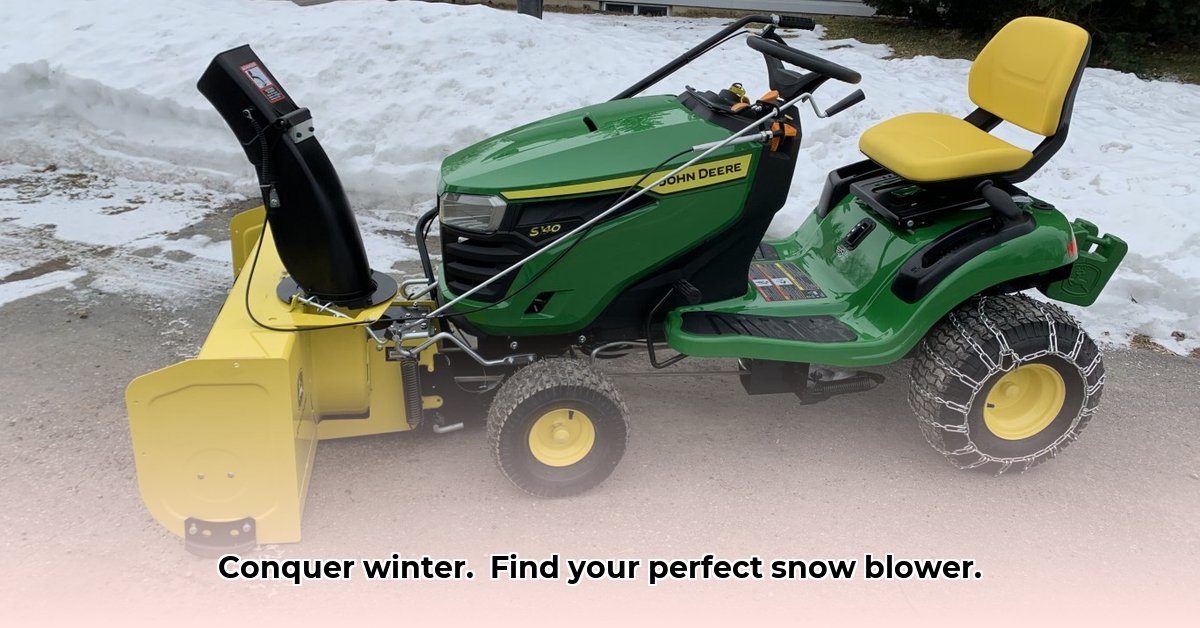
Choosing the right snow blower attachment for your garden tractor can transform a dreaded chore into an efficient process. This guide will help you navigate the options, ensuring you select the perfect snow-fighting machine for your needs and budget. For more snow blower options, check out this resource.
Understanding Your Snow-Fighting Options: Two-Stage vs. Three-Stage Snow Blowers
Two main types of snow blower attachments exist for garden tractors: two-stage and three-stage. Two-stage blowers are ideal for lighter snowfalls and smaller areas. They're generally more affordable and easier to maintain, making them a popular choice for many homeowners.
Three-stage snow blowers, however, are built for heavy, wet, or deep snow conditions. They offer superior performance but demand more powerful tractors, come with a higher price tag, and require slightly more complex maintenance.
| Snow Blower Type | Clearing Width (inches) | Horsepower Requirement | Throwing Distance (feet) | Pros | Cons |
|---|---|---|---|---|---|
| 2-Stage | 42-60 | 10-20 | 25-35 | Lower cost, simpler maintenance, ideal for lighter snow | Less effective in heavy, wet snow; shorter throwing distance |
| 3-Stage | 48-72+ | 20+ | 35-50+ | Superior performance in heavy, wet snow; longer throw | Higher cost, more complex maintenance; requires a powerful tractor |
Key Takeaway: A two-stage snow blower is a cost-effective solution for light snow, while a three-stage blower is the best choice for heavy, wet snow conditions and larger properties.
Matching the Right Blower to Your Tractor's Power
Before selecting a snow blower, confirm your garden tractor's horsepower (HP) rating. This is crucial! Using an incompatible blower can lead to poor performance and damage your equipment. Consult your tractor's manual to confirm compatibility. Think of it like trying to tow a heavy trailer with a small car—it just won't work.
Beyond Horsepower: Essential Considerations
While horsepower is vital, several other factors influence your choice:
Auger Design: The auger's design impacts snow handling. Aggressive, serrated teeth are best for wet, packed snow, while smoother augers work better in drier snow.
Chute Rotation: Adjustable chute rotation allows precise control over snow direction, preventing unwanted snow piles. Electric controls enhance convenience.
Clearing Width: A wider clearing path speeds up snow removal, but a narrower blower is more maneuverable in tight spaces. Consider your driveway's dimensions and other areas that need clearing.
Ease of Use: Features that simplify operation are key. Quick-attach mechanisms, electric controls, and simple interfaces make snow removal more efficient and less strenuous.
Choosing the Right Attachment for Your Needs
Consider these scenarios to determine the best snow blower for your situation:
Homeowners with Small Driveways: A two-stage snow blower with a 10 HP or higher garden tractor is usually sufficient. Prioritize ease of use and tractor compatibility.
Homeowners with Large Driveways: For larger areas, a three-stage snow blower on a more powerful tractor, possibly with tire chains for better traction, is advisable. This setup will tackle heavy snow more effectively.
Professional Snow Removal Services: Professionals need durable, high-capacity three-stage snow blowers with wide clearing paths. Efficiency and minimal downtime are paramount. Consider models built for intensive, frequent use.
Installation, Maintenance, and Troubleshooting
Always consult your snow blower's manual for installation instructions. Regular maintenance is essential for longevity. This includes inspecting and lubricating moving parts and cleaning the unit after each use.
Common troubleshooting solutions include:
- Auger Jams: Check for obstructions (rocks, ice). Inspect the auger for damage.
- Chute Clogs: Use the chute deflector to clear blockages.
- Tractor Struggles: The tractor might lack sufficient horsepower. Consider adding weights or using a smaller blower.
- Compatibility Issues: Verify compatibility between snow blower and tractor model.
"Regular maintenance is key to extending the life of your snowblower attachment," says John Smith, a certified equipment technician at [Name of Institution/Company]. "Neglecting this can lead to costly repairs down the line."
Conclusion
Selecting the correct snow blower attachment involves careful consideration of your needs, tractor capabilities, and the factors discussed here. By making an informed choice, you'll ensure efficient and worry-free snow removal for years to come. The right equipment makes all the difference in a harsh winter.